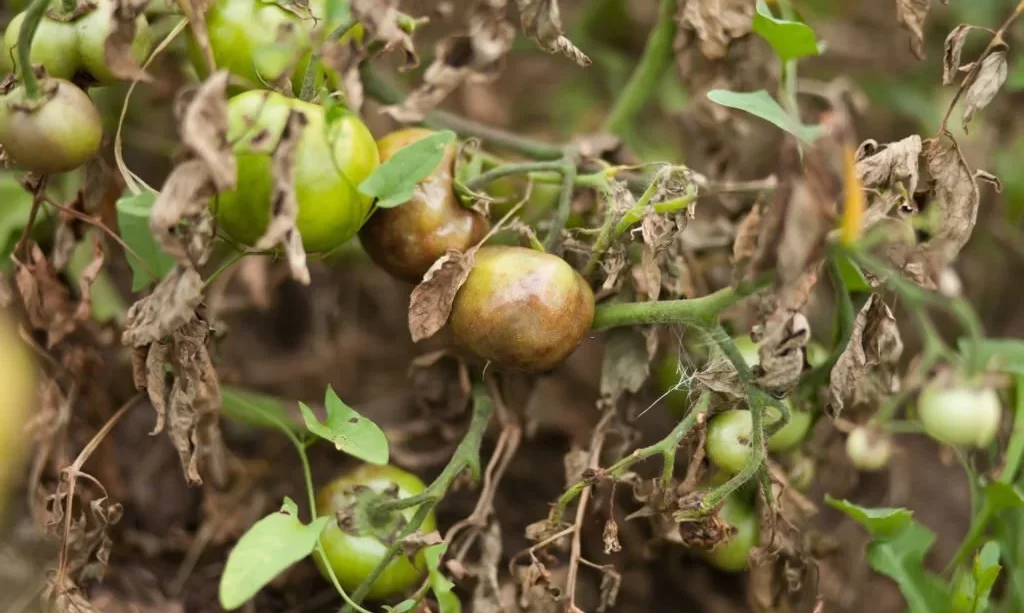Tomatoes are a beloved addition to many gardens, prized for their juicy fruit and vibrant green foliage. However, it’s not uncommon for tomato growers to notice that their tomato leaves are turning brown, which can raise concerns about the plant’s overall health. In this article, we will explore the various reasons why tomato leaves may turn brown, from natural leaf aging to environmental factors, diseases, and pests. By understanding these causes, you’ll be better equipped to address the issue and promote the well-being of your tomato plants, ultimately ensuring a fruitful harvest.
- Increases Vigor And Volume Of Tomatoes And Vegetables
- Ideal For Vegetables, Trees, Shrubs And Flowers
- Helps Plants Tolerate Drought
- No Assembly Required
Natural Leaf Aging
As tomato plants grow and develop, their leaves go through a natural aging process. This process can involve the gradual browning of older leaves, and it’s a perfectly normal occurrence. Here’s what happens during natural leaf aging:
- Leaf Senescence: Just like any living organism, tomato plants have a finite lifespan for their leaves. As leaves age, they undergo senescence, a natural aging process.
- Yellowing and Browning: Initially, you may notice that the lower leaves of your tomato plant start to turn yellow. This yellowing is a sign that the leaf is reaching the end of its life cycle. As the leaf ages further, it may progress to brown or even develop small brown spots.
- Nutrient Redistribution: During this aging process, the plant reabsorbs valuable nutrients from these older leaves and redirects them to younger leaves and developing fruit. This nutrient reallocation is essential for the overall health of the tomato plant.
It’s important to note that some level of browning on older tomato leaves is entirely natural and not cause for alarm. In fact, this process helps the plant prioritize the growth of new foliage and fruit. However, it’s equally important to distinguish between natural leaf aging and abnormal browning caused by diseases, pests, or environmental stressors. In the following sections, we will delve into these other potential causes of tomato leaf browning and how to identify and address them.
Fungal Diseases
Tomato plants are susceptible to various fungal diseases that can lead to the browning of leaves and compromise overall plant health. Here’s an overview of common fungal diseases affecting tomato plants:
- Early Blight (Alternaria solani): Early blight is a prevalent fungal disease that manifests as dark brown or black spots with concentric rings on tomato leaves. These spots can enlarge and cause the leaves to yellow and eventually die. The fungus responsible for early blight can also infect stems and fruit.
- Septoria Leaf Spot (Septoria lycopersici): Septoria leaf spot is another common fungal disease characterized by small, dark brown spots with a lighter center on tomato leaves. As the disease progresses, affected leaves may turn yellow and drop prematurely. This can weaken the plant and reduce fruit production.
- Late Blight (Phytophthora infestans): While late blight is more infamous for affecting potatoes, it can also affect tomato plants. It causes brown lesions on leaves and can rapidly spread during wet and cool conditions. Late blight can lead to significant crop loss if not managed promptly.
Managing Fungal Diseases:
- Fungicides: In severe cases of fungal infections, chemical fungicides may be necessary. Follow the manufacturer’s instructions for safe and effective use.
- Pruning: Remove and discard infected leaves to prevent the spread of fungal spores.
- Proper Spacing: Ensure adequate spacing between tomato plants to promote air circulation, which can help reduce humidity and fungal growth.
- Mulching: Apply a layer of mulch around the base of plants to prevent soil splashing onto leaves, which can harbor fungal spores.
- Water at the Base: Water the soil directly around the base of the plant rather than overhead to minimize moisture on leaves.
Bacterial Infections
Bacterial infections can also cause browning and damage to tomato leaves. Two common bacterial infections that affect tomatoes are:
- Bacterial Canker (Clavibacter michiganensis subsp. michiganensis): Bacterial canker leads to angular, brown lesions on leaves, often surrounded by a yellow halo. It can cause wilting and dieback of plant tissue, affecting overall plant health. Bacterial canker can be particularly challenging to manage once established.
- Bacterial Speck (Pseudomonas syringae pv. tomato): Bacterial speck appears as small, dark brown to black lesions with a raised, rough texture on tomato leaves. These lesions can be numerous and may lead to leaf yellowing and defoliation, especially in humid conditions.
Managing Bacterial Infections:
- Sanitation: Remove and destroy infected plant material promptly to prevent the spread of bacteria.
- Avoid Overhead Watering: Minimize splashing of contaminated soil onto leaves by watering at the base of the plant.
- Resistant Varieties: Some tomato varieties are bred for resistance to specific bacterial diseases, so consider planting resistant varieties if these diseases are prevalent in your area.
- Copper-based Sprays: In some cases, copper-based sprays may help reduce bacterial infection spread, but they are more effective for prevention than for treating established infections.
By recognizing the signs of fungal diseases and bacterial infections and taking appropriate measures, you can address these issues and minimize the browning of tomato leaves. In the following sections, we will explore additional causes of tomato leaf browning, including environmental stress and nutrient deficiencies, and how to manage them effectively.
Environmental Stress
Environmental stress factors can contribute to the browning of tomato leaves. These stressors can include adverse weather conditions and improper care practices. Here’s how environmental stress can affect tomato plants:
- Drought Stress: Insufficient watering or prolonged periods of drought can cause the leaves of tomato plants to wilt and turn brown, starting from the edges and tips. This condition is known as leaf scorch.
- Excessive Heat: Extreme heat, especially when combined with inadequate moisture, can lead to sunburn on tomato leaves. This can result in browning, particularly on the exposed upper leaves.
- Inconsistent Watering: Fluctuations in soil moisture levels, such as erratic watering schedules, can stress tomato plants. This stress may cause leaf edges to turn brown or curl.
- Inadequate Shade: Tomatoes are sensitive to excessive sunlight during hot weather. Without adequate shading or protection, leaves may become scorched and develop brown patches.
- Overcrowding: Planting tomatoes too closely together can lead to overcrowding, restricting air circulation and trapping moisture between plants. This can create a humid microenvironment that encourages fungal diseases and leaf browning.
Managing Environmental Stress:
- Consistent Watering: Maintain a regular watering schedule, ensuring that the soil remains consistently moist but not waterlogged. Water at the base of the plants to avoid wetting the foliage.
- Mulching: Apply a layer of organic mulch around the base of the plants to retain soil moisture, regulate temperature, and reduce weed competition.
- Provide Shade: During exceptionally hot periods, provide temporary shade using shade cloth, garden fabric, or even an umbrella to shield the plants from intense sunlight.
- Proper Spacing: Plant tomato seedlings with adequate spacing to promote air circulation and reduce humidity between plants.
- Prune Excess Foliage: Prune some of the lower leaves to improve air circulation and reduce overcrowding. This can also redirect the plant’s energy toward fruit production.
Nutrient Deficiencies
Tomato plants require a balanced supply of essential nutrients to thrive. Nutrient deficiencies can manifest as leaf browning and other symptoms. Here are some common nutrient deficiencies that affect tomato plants:
- Magnesium Deficiency: A lack of magnesium can lead to interveinal browning on tomato leaves, where the tissue between the leaf veins turns brown while the veins remain green.
- Nitrogen Deficiency: Insufficient nitrogen can result in overall yellowing of the leaves, which may then develop brown or yellow patches.
- Calcium Deficiency: Calcium deficiency can cause blossom end rot in tomatoes, which appears as dark, leathery patches on the bottom of the fruit rather than on the leaves.
Managing Nutrient Deficiencies:
- Soil Testing: Conduct a soil test to determine nutrient levels in your garden. This will help you identify deficiencies and guide your fertilizer choices.
- Balanced Fertilization: Apply a balanced fertilizer that provides essential nutrients, including nitrogen, phosphorus, potassium, magnesium, and calcium, according to soil test recommendations and the specific needs of your plants.
- Foliar Feeding: In cases of severe nutrient deficiencies, you can apply a water-soluble fertilizer as a foliar spray to provide a quick nutrient boost. However, addressing nutrient deficiencies through soil amendments is generally more effective in the long term.
By addressing environmental stress factors and ensuring your tomato plants receive adequate nutrients, you can prevent and alleviate leaf browning caused by these factors. In the following sections, we’ll explore the role of pests and conclude by summarizing the key points discussed in this article.
- FOR USE ON: Use Tomato-tone organic fertilizer for all types of tomatoes; both heirloom and hybrid. It Produces plump, abundant tomatoes, not unwanted foliage. Can also be used on all vegetables.
- CONTAINS: Tomato-tone is a rich blend of the finest natural & organic ingredients enhanced with our exclusive Bio-tone formula; 3-4-6 Fertilizer analysis with 8% calcium to help prevent blossom end rot. Tomato-tone is environmentally Safe – No sludges or toxic ingredients.
- WHEN / HOW TO USE: Best to use Tomato-tone fertilizer every two weeks through the growing season. Apply to the soil around the drip line of the plant and then water thoroughly. Tomato-tone is ready to use and requires no mixing.
- FOR ORGANIC GARDENING: Tomato-tone is approved for organic gardening; It is a registered Organic Input Material meaning it meets all requirements for organic production.
- MADE IN THE USA: Product of the Espoma Company. The leader in natural organics since 1929
Pest Damage
Pests can be a persistent challenge for tomato plants, and their damage can lead to browning and deterioration of leaves. Here are some common pests that can affect tomato plants:
- Aphids: These tiny, sap-sucking insects can congregate on the undersides of tomato leaves, causing them to curl and turn brown. Aphid infestations can also lead to the growth of sooty mold on affected leaves.
- Spider Mites: Spider mites are microscopic arachnids that feed on plant sap. Their feeding damage can cause stippling and bronzing of tomato leaves, resulting in a mottled appearance.
- Whiteflies: Whiteflies are small, winged insects that feed on the undersides of tomato leaves. Their feeding can cause leaves to yellow, curl, and develop a sticky residue. As the leaves age, they may turn brown and become coated with honeydew and sooty mold.
- Hornworms: Tomato hornworms are large green caterpillars that can devour tomato foliage. Their feeding can lead to defoliation and browning of leaves.
Managing Pest Damage:
- Physical Removal: Handpick or prune affected leaves to remove pests like hornworms or heavily infested areas.
- Insecticidal Soap: For small infestations of aphids, whiteflies, or spider mites, you can use insecticidal soap to control these pests. Follow the product instructions carefully.
- Beneficial Insects: Encourage natural predators like ladybugs and lacewings, which feed on aphids and other tomato pests.
- Neem Oil: Neem oil can be effective against a variety of tomato pests. Dilute it according to the instructions and apply as a spray.
- Row Covers: Use row covers to physically exclude pests from your tomato plants. This can be particularly helpful for preventing infestations.
- Companion Planting: Some companion plants, like basil and marigolds, can help deter certain tomato pests when planted nearby.
Conclusion
The browning of tomato leaves can result from various factors, including natural leaf aging, fungal diseases, bacterial infections, environmental stress, nutrient deficiencies, and pest damage. Identifying the underlying cause of leaf browning is crucial for effective management and maintaining the overall health of your tomato plants.
Regular monitoring and proactive measures, such as proper watering, mulching, and pest control, can help prevent and address many of these issues. Additionally, practicing good garden hygiene, such as removing and disposing of affected plant material, can help reduce the spread of diseases and pests.
By implementing these strategies and taking a holistic approach to tomato plant care, you can enjoy healthy, vibrant foliage and a bountiful harvest of delicious tomatoes from your garden.





